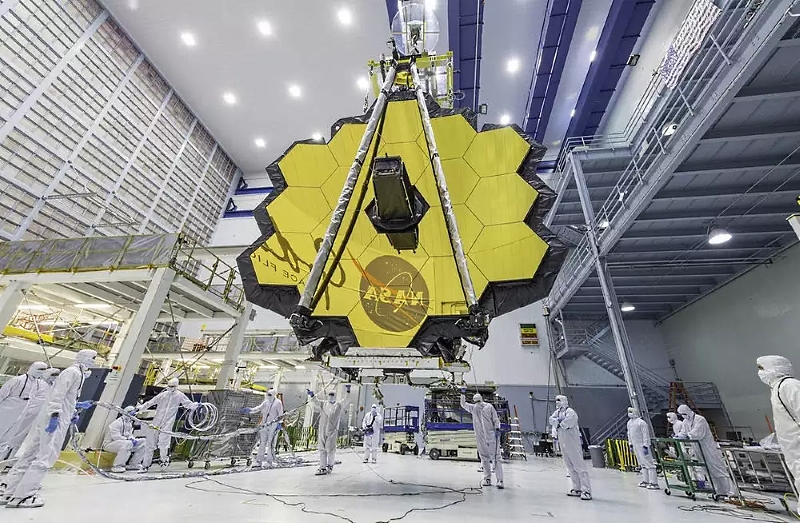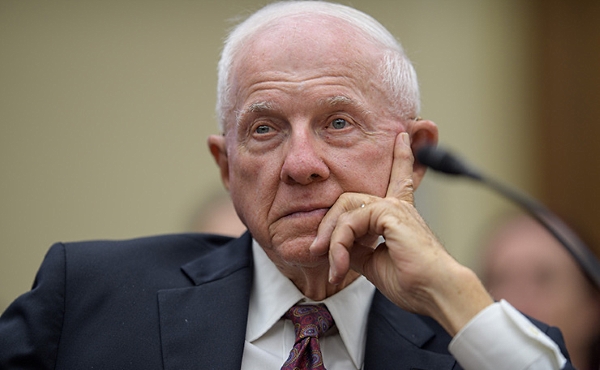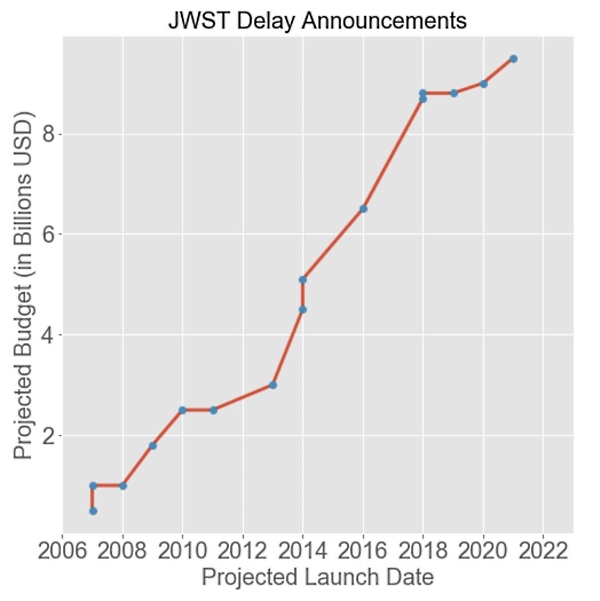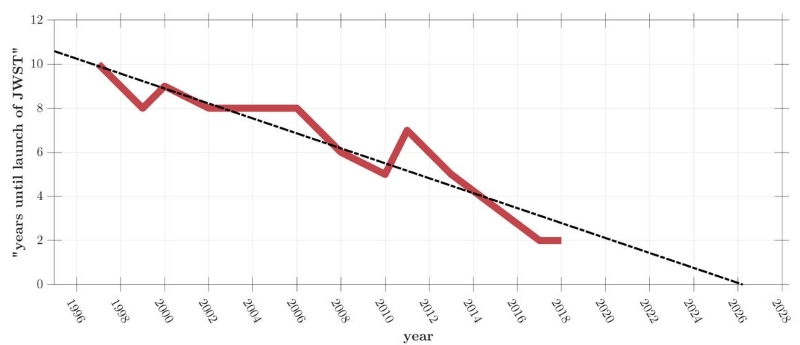Telescope beyond reasonable
Personally, I came to the conclusion that the James Webb telescope carries too many inventions, too many risks and is a project beyond reason. - these are direct wordsTom Young, head of the independent control commission, at a meeting of the Committee on Astronomy and Astrophysics of the Space Research Council of the United States National Academy of Sciences on October 29. However, he immediately clarified that he was not an opponent of the telescope and had no doubt that the project could be completed successfully. Indeed, the state of affairs causes controversial feelings - on the one hand, this is an interesting project that should give science new opportunities, on the other hand, exceeding deadlines and costs have reached truly astronomical magnitudes. In general, the history of the project makes you think about the timeliness of technology implementation and the criteria when it is better to stop. Well, and finally, the lessons of “James Webb” are categorically necessary to learn, starting a much larger project of the near-moon orbital station.

NASA / Desiree Stover Photo
To make Young's comment more understandable, it is worth explaining the context. In 2010, when the project of the telescope “James Webb” once again violated the previously announced deadlines and cost, Senator Barbara Mikulski demanded an independent monitoring commission. According to the results of its work, NASA restructured the project and assured the US Congress that the cost would not exceed $ 8 billion, and the telescope would be launched no later than autumn 2018. But in the fall of 2017, the dates moved to 2019, and in the spring of 2018 - to 2020. NASA, without waiting for senatorial rage , gathered a new independent commission on its own. It includes authoritative aerospace experts, and Tom Young, who worked at Lockheed Martin, became the head.

Tom Young, photo by NASA / Bill Ingals
The commission completed its work in May 2018 and the 31st submitted a report. In it, based on estimates of the complexity and timing of the project in the context of various delays, problems and accidents , it was recommended to set the launch date for March 2021. The result would be an excess of 8 billion ceiling set by Congress. The report also made 32 recommendations for improving processes.
Now we are transported to autumn 2018. On October 29, a meeting of the Committee on Astronomy and Astrophysics of the Space Research Council of the United States Academy of Sciences was held. No wonder Tom Young performed on it. The portal SpaceNews cites his words:
The original James Webb telescope was supposed to cost $ 500 million and go into space in 2007. But the initial cost estimates have increased 19 times, and the dates have moved by 14 years.

Grant Tremblay illustration
It is expected that now it is a pity to throw away the billions of dollars already spent, so James Webb will be launched and, I hope, will become an excellent telescope. But his brethren from the large NASA strategic space missions are showing far greater successes. For example, launched this year, the Parker Solar Probe cost just a half billion. But smaller caliber missions with small budgets look great against the background of “James Webb” - recently started working in orbit and having already found the first exoplanets TESS cost 200 million, while saving 40 and completed two months earlier than planned. Simple mathematics says that the cost of JWST could be run almost 50 vehicles with a budget TESS, six analogues Parker Solar Probe or 3 analogs of the rover "Curvature." And I suspect
A separate sad humor lies in the fact that the analysis of postponements gives a start date in 2026. The calculation is, of course, not serious, but in the area of 2021 it is worth remembering about it.

Corey S. Powell illustration
The sad story of "James Webb" leads to several conclusions:
Technological jumps are best done on relatively cheap test instruments. NASA had an excellent experience with the Deep Space 1 probe, on which they tested twelve new technologies that were later successfully used in subsequent missions. The probe cost, by the way, only two hundred and a few million dollars at today's prices. The European Space Agency has a good example - the success of LISA Pathfinder. This device shows the ability to create a space detector of gravitational waves from several satellites, and the fact that their design will not differ much from the already operating device increases the accuracy of estimating the timing and cost of the project. Yes, of course, there may be an objection that there will be no special sense from “mini-JWST”, but this is a matter of designing the device and inventing tasks for it. Practice is the criterion of truth
A smooth and imperceptible increase in the cost and timing of a project can go very far, and it is necessary to have clear criteria for when the situation goes over the edge. This advice, by the way, is universal, especially since the human psyche contains irrational avoidance of losses (remember the Max Bazerman experiment with a twenty- dollar bill at auction). Specifically, in the case of "James Webb" in 2010-11, the cost gradually increased from 5 to 6.5, and then to 8 billion. And by that time they managed to spend about 3 billion, which, of course, was very sorry to throw out. Until 2011, a fork with an audit and a chance to close the project is not visible. NASA document 2006 gives an estimate of the value of 3.3 billion, less than that of Hubble, and now looks like a very graphic illustration.

NASA / Desiree Stover Photo
Board Committees
To make Young's comment more understandable, it is worth explaining the context. In 2010, when the project of the telescope “James Webb” once again violated the previously announced deadlines and cost, Senator Barbara Mikulski demanded an independent monitoring commission. According to the results of its work, NASA restructured the project and assured the US Congress that the cost would not exceed $ 8 billion, and the telescope would be launched no later than autumn 2018. But in the fall of 2017, the dates moved to 2019, and in the spring of 2018 - to 2020. NASA, without waiting for senatorial rage , gathered a new independent commission on its own. It includes authoritative aerospace experts, and Tom Young, who worked at Lockheed Martin, became the head.

Tom Young, photo by NASA / Bill Ingals
The commission completed its work in May 2018 and the 31st submitted a report. In it, based on estimates of the complexity and timing of the project in the context of various delays, problems and accidents , it was recommended to set the launch date for March 2021. The result would be an excess of 8 billion ceiling set by Congress. The report also made 32 recommendations for improving processes.
Now we are transported to autumn 2018. On October 29, a meeting of the Committee on Astronomy and Astrophysics of the Space Research Council of the United States Academy of Sciences was held. No wonder Tom Young performed on it. The portal SpaceNews cites his words:
There are people who support JWST at any cost, and there are those who support it, but are outraged by the increase in time and cost. I believe that the project will not be closed, and the political process will not do anything wrong with the telescope.He also added that he does not exclude "collateral damage" to other NASA programs, but did not predict specific solutions. Explanation: Now the question of delaying or canceling the WFIRST infrared telescope is being decided at NASA and the US administration in order to transfer money to JWST.
I know that now we are starting projects, in comparison with which “James Webb” will look small. And these missions must take into account the JWST experience. I think that the next decade will have to break the head over this problem.Young also spoke about the difficulties of convincing NASA of the validity of the recommendations. It took a lot of effort to prove that NASA can and should control the preparation for the flight of the European Ariane 5 rocket, on which the telescope should be launched. Initially, NASA claimed that this was impossible, but representatives of the commission were able to eventually convince the agency.
If this program did not have high scientific potential and would not touch on questions of US leadership, I think it would be closed.
Outstanding nightmare
The original James Webb telescope was supposed to cost $ 500 million and go into space in 2007. But the initial cost estimates have increased 19 times, and the dates have moved by 14 years.

Grant Tremblay illustration
It is expected that now it is a pity to throw away the billions of dollars already spent, so James Webb will be launched and, I hope, will become an excellent telescope. But his brethren from the large NASA strategic space missions are showing far greater successes. For example, launched this year, the Parker Solar Probe cost just a half billion. But smaller caliber missions with small budgets look great against the background of “James Webb” - recently started working in orbit and having already found the first exoplanets TESS cost 200 million, while saving 40 and completed two months earlier than planned. Simple mathematics says that the cost of JWST could be run almost 50 vehicles with a budget TESS, six analogues Parker Solar Probe or 3 analogs of the rover "Curvature." And I suspect
A separate sad humor lies in the fact that the analysis of postponements gives a start date in 2026. The calculation is, of course, not serious, but in the area of 2021 it is worth remembering about it.

Corey S. Powell illustration
Final reflections
The sad story of "James Webb" leads to several conclusions:
Technological jumps are best done on relatively cheap test instruments. NASA had an excellent experience with the Deep Space 1 probe, on which they tested twelve new technologies that were later successfully used in subsequent missions. The probe cost, by the way, only two hundred and a few million dollars at today's prices. The European Space Agency has a good example - the success of LISA Pathfinder. This device shows the ability to create a space detector of gravitational waves from several satellites, and the fact that their design will not differ much from the already operating device increases the accuracy of estimating the timing and cost of the project. Yes, of course, there may be an objection that there will be no special sense from “mini-JWST”, but this is a matter of designing the device and inventing tasks for it. Practice is the criterion of truth
A smooth and imperceptible increase in the cost and timing of a project can go very far, and it is necessary to have clear criteria for when the situation goes over the edge. This advice, by the way, is universal, especially since the human psyche contains irrational avoidance of losses (remember the Max Bazerman experiment with a twenty- dollar bill at auction). Specifically, in the case of "James Webb" in 2010-11, the cost gradually increased from 5 to 6.5, and then to 8 billion. And by that time they managed to spend about 3 billion, which, of course, was very sorry to throw out. Until 2011, a fork with an audit and a chance to close the project is not visible. NASA document 2006 gives an estimate of the value of 3.3 billion, less than that of Hubble, and now looks like a very graphic illustration.
Only registered users can participate in the survey. Sign in , please.
Do you think it was worth closing the JWST project in 2011?
- 21.3% yes 111
- 78.6% No 408
What year do you think JWST will be launched?
- 21.4% 2,021 115
- 21.8% 2022 117
- 31.5% 2023-2024 169
- 14.9% 2025-2030 80
- 10% Never 54
